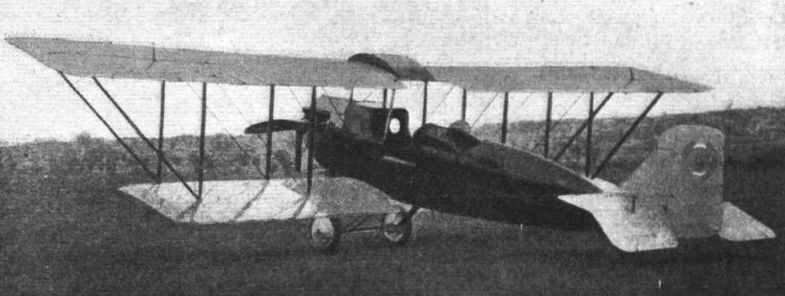
Варианты
- Standard - J-1 - 1917 - США
- Lincoln-Standard - LS.5 - 1923 - США
Flight, December 1923
TWO RECENT AMERICAN COMMERCIAL PLANES
The Lincoln-Standard L.S.5 and the Laird Limousine
THE Lincoln-Standard L.S.5 was designed by O. W. Timm, chief engineer of the Lincoln-Standard Aircraft Corporation, of Lincoln, Neb., to meet the demand for a practical five-seater commercial passenger-carrying aeroplane. Tests with the first model proved to be very successful, and the machine was put into production. Safety and comfort for the passengers were the first considerations. Among the other principal points that were carefully considered are, the safety factor, durability, economy of operation, repair and replacement of parts, and minimum of work in up-keep, etc.
As regards the construction of the machine, the fuselage is of orthodox rectangular cross-section, the maximum depth being 4 ft. 4 ins. and the maximum width 2 ft. 9 ins. The passenger compartment is 4 ft. 9 ins. in length, and is richly upholstered with maroon-coloured leather. Accommodation is provided for four passengers with comfort, two being seated facing forward and two seated opposite looking aft. The passengers are protected from the wind by the partially enclosed portion of the cockpit. This enclosed portion, resembling the "cab" of a locomotive, is constructed of plywood, and is provided with circular windows. Three steps on the outside of the fuselage five access to the passengers' cockpit.
The longerons are of ash, braced with 3/32-in. three-ply Haskelite walls and plywood bulkheads from the nose to the pilot's cockpit, which is located immediately behind the passengers' compartment. Aft of the pilot's cockpit the fuselage is of the usual girder construction, fabric covered. The interior wood parts are covered with several coats of Valspar varnish, the exterior is finished in dark maroon, Valspared, while the motor compartment is painted with a grey fire-resisting paint. The engine is enclosed by a motorcar type "bonnet" of polished aluminium, hinged at the top and sides, and held in place by six spring fasteners.
The wings are constructed in conventional truss form, the top plane being of larger span than the lower. The overhang is braced with steel tubing, streamlined with Balsa wood. The top plane is in two main panels and one centre section, and the lower plane is in two panels. In the centre section, which is built up of two main spars and plywood, is the 42-gallon petrol tank, provided with a positive sight gauge. The wing spars are of spruce, routed to I-beam section, and the ribs are of the web type. Ailerons are fitted to the top plane only, being hinged to the rear spar. Wing fittings are of plate form. The interplane struts are attached to universal sockets and secured with pins. The wings are covered with a long fibre cotton fabric, and doped with four coats of acetate and two coats of nitrate dope pigmented with aluminium.
The horizontal stabiliser is of the non-lifting type, and is constructed of wood braced with cable. The elevators are of wood, built up on a continuous steel tube, whilst the rudder, which is balanced, is constructed with a steel tube main spar and trailing edge, and wood ribs.
A conventional V-type landing gear is fitted, being attached to the fuselage with hinge-fittings. The struts arc of steel tubing, streamlined with Balsa wood. Two 30-in by 5-in. wheels run on a nickel-steel tubular axle, 2 1/4 ins. in diameter.
The axle is not provided with guides, but the action in limited by the 1/2-in. elastic absorber cord wrapped on the spools, and a safety cable is also fitted. The wheels are streamlined with aluminium covers. The tail skid is mounted on a swivel post and secured with 3/8-in. elastic absorber cord. This skid is of hickory and is provided with a spring steel shoe.
The engine fitted in the Lincoln-Standard L.S.5 is the famous eight-cylinder Hispano-Suiza, developing 180 h.p. at 1,750 i.p.m. The cooling system consists of two side radiators, with an expansion tank mounted between the cylinder blocks. The oil tank is located at the back of the engine. All the water, petrol, and oil lines are fitted with flexible couplings. The exhaust is carried down at the nose of the fuselage, thereby keeping the exhaust fumes clear of the cockpit and lessening the noise of the exhaust. A booster magneto is provided for starting the engine.
The principal characteristics of this machine are as follows :-
Span, top 44 ft. 7 ins.
Span, bottom 30 ft. 0 ins.
Chord 6 ft. 0 ins.
Gap 6 ft. 0 ins.
Dihedral angle 1°.
Sweepback 5°.
Stagger 5 1/2 ins.
Overall height 10 ft. 7 ins.
Wing section R.A.F.3
Area of top plane (incl. ailerons) 267 sq. ft.
Area of bottom plane 180 sq. ft.
Total wing area 447 sq. ft.
Area of ailerons (two) 42 sq. ft.
Area of stabiliser 23-7 sq. ft
Area of elevators 22-8 sq. ft
Area of rudder 12 sq. ft.
Area of fin 4-6 sq. ft
Weight, empty 1,735 lbs.
Weight, fully laden 2,922 lbs.
Pay load 720 lbs.
Loading per h.p. 16-2 lbs.
Loading per sq. ft. 6-5 lbs.
Speed range 34-93 m.p.h
Climb in 10 minutes 5,200 ft.
Ceiling 18,000 ft.
Fuel capacity: petrol 42 gals.
Fuel capacity: oil 5 gals.
Radius of action 310 miles.
<...>
- Flight, December 1923
TWO RECENT AMERICAN COMMERCIAL PLANES
Фотографии
-
Flight 1923-12 / Flight
THE LINCOLN-STANDARD L.S.5 COMMERCIAL AEROPLANE: Three-quarter rear view of tbe complete machine, showing the semi-enclosed cabin, seating four passengers.
-
Flight 1923-12 / Flight
THE LINCOLN-STANDARD L.S.5 COMMERCIAL AEROPLANE: Three close-up views: on the left, the 180 h.p. Hispano-Suiza engine in situ; centre, the passengers' and pilot's cockpits; right, the landing gear.
- Фотографии

